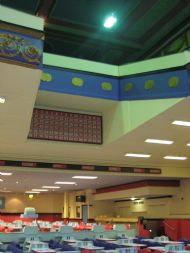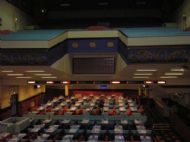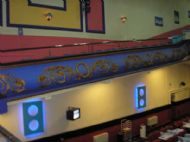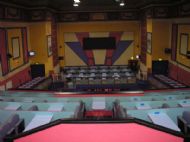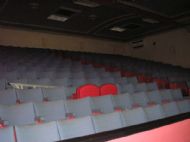 Swansea's Albert Hall Reborn | sitemap | log in Swansea's Albert Hall Reborn | sitemap | log in
|
 |
||||||||||||||||||||||
| This is a free Spanglefish 1 website. | ||||||||||||||||||||||
The interior of the Albert Hall is full of glorious Victorian architecture with magnificently high walls covered in elaborate plasterwork, beautifully scrolled balcony fronts, intricate and stunning ceiling grids and an enormous balcony seating area that still has its 1000 plus seats intact! Then there is the huge performance area where the original stage and screen once proudly sat. The hall initially had a capacity exceeding 2500. The panelling around the walls on the platform is truly stunning. It's amazing to think that most of these were simply not visible to the general movie-going audience in its years as a cinema.
The Albert Hall has not always been known by that name. For the first 17 years of it’s life it was simply called 'The Music Hall' until other similar establishments started to open as competition: The Star Music Hall on Wind Street being it’s greatest competitor. But none were as grand and the Albert Hall never really staged Music Hall as we know it; that was left to the lesser halls in town. But business quickly fell on hard times due to its desire to stay above the common Music Halls that were becoming more and more popular in Swansea. After a rethink by the management, the Music Hall was renamed the Albert Hall in 1881, 11 years after Queen Victoria opened the Royal Albert Hall in Kensington. This was a clever move by the owners as it certainly turned its fortunes around. From then on it became a popular place of top class entertainment for Swansea residents. The name 'Albert Hall' has not been seen outside the hall since the early 1900's.
In the early heydays of the Albert Hall, the stage held performances by some of the country’s-indeed the worlds-greatest poets, choirs, opera singers and the like, the most famous performer being Adelina Patti, who performed many a recital from the stage and often declared it to be one of her favorite places to perform. A series of concerts performed by her at the Albert Hall contributed greatly to the transfer of her summer pavilion at Craig Y Nos to the seafront in Swansea. That pavilion was given to Swansea Corporation in 1919, named the Patti Pavilion and it is still there today on Swansea’s stunning seafront.
A further series of concerts by her, attended by almost 15000 people, helped raise money towards the building of a new wing for a hospital in Swansea, St Helens Hospital on St Helens Road, fondly remembered as the Swansea Infirmary. Indeed her regular financial input certainly help to kept that building open. Any concert given by this lady would be accompanied by great fanfare and much lining of the streets from High Street station to the doors of the Albert Hall where she was greeted by the gentry of the city. She gave her last ever concert on Oct 22nd 1910 in aid of Swansea Red Cross.
After his much-heralded tour of American, Oscar Wilde did a tour of Great Britain and it was at the Albert Hall where he appeared on 29th March 1884. His subject matter: 'How to arrange your household furniture!!!' The hall was packed!
In 1901 the Albert Hall was the chosen venue for the Swansea district memorial of the death of Queen Victoria. Likewise, a memorial concert was held after the 1912 disaster of the passenger liner, Titanic.
The Albert Hall was always an important name on the social and political-speakers rally circuit and people would travel across the UK to speak or listen. The Albert was a very popular part of Swansea daily social life. Church services were often held there and even a few marriages! Between 1895 and 1910 the hall was used frequently as a chapel by the Rev. Oscar Thompson Snelling.
This wonderful variety of entertainment continued for almost the next 70 years before the next big stage of its life began: its life as most remember it, as a cinema.
|  |
|||||||||||||||||||||
 | ||||||||||||||||||||||


